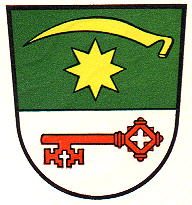Bad Sassendorf: Difference between revisions
Knorrepoes (talk | contribs) No edit summary |
Knorrepoes (talk | contribs) m (Text replace - "[[Literature" to "{{media}} [[Literature") |
||
| Line 21: | Line 21: | ||
The arms show in the upper part a scythe as the symbol of agriculture. The area has a rich agricultural soil. The star is the star of the salt-owners. In the 12<sup>th</sup> century salt mining was already mentioned in the area. In 1872 the salty water was used in a spa and the prefix Bad was granted. The guild of salt miners used the star as a symbol. The key in the lower part is taken from the arms of [[Soest (Westfalen)|Soest]], as the former Amt Lohne reached to the city walls of Soest until 1803. | The arms show in the upper part a scythe as the symbol of agriculture. The area has a rich agricultural soil. The star is the star of the salt-owners. In the 12<sup>th</sup> century salt mining was already mentioned in the area. In 1872 the salty water was used in a spa and the prefix Bad was granted. The guild of salt miners used the star as a symbol. The key in the lower part is taken from the arms of [[Soest (Westfalen)|Soest]], as the former Amt Lohne reached to the city walls of Soest until 1803. | ||
{{media}} | |||
[[Literature]] : Stadler, K. : Deutsche Wappen - Bundesrepublik Deutschland. Angelsachsen Verlag, 1964-1971, 8 volumes. | [[Literature]] : Stadler, K. : Deutsche Wappen - Bundesrepublik Deutschland. Angelsachsen Verlag, 1964-1971, 8 volumes. | ||
Revision as of 18:24, 8 July 2014
| Heraldry of the World Civic heraldry of Germany - Deutsche Wappen (Gemeindewappen/Kreiswappen) |
BAD SASSENDORF
State : Nordrhein-Westfalen
District (Kreis) : Soest
Additions : 1975 Amt Lohne, Amt Oestinghausen (partly), Bettinghausen, Beusingsen, Elfsen, Gabrechten, Heppe, Herringsen, Lohne, Neuengeseke, Opmünden, Ostinghausen, Weslarn
Official blazon
Origin/meaning
The arms were granted in 1970 and are based on the arms of Amt Lohne, the predecessor of the present municipality.
The arms show in the upper part a scythe as the symbol of agriculture. The area has a rich agricultural soil. The star is the star of the salt-owners. In the 12th century salt mining was already mentioned in the area. In 1872 the salty water was used in a spa and the prefix Bad was granted. The guild of salt miners used the star as a symbol. The key in the lower part is taken from the arms of Soest, as the former Amt Lohne reached to the city walls of Soest until 1803.
Contact and Support
Partners:
Your logo here ?
Contact us
© since 1995, Heraldry of the World, Ralf Hartemink 
Index of the site
Literature : Stadler, K. : Deutsche Wappen - Bundesrepublik Deutschland. Angelsachsen Verlag, 1964-1971, 8 volumes.











